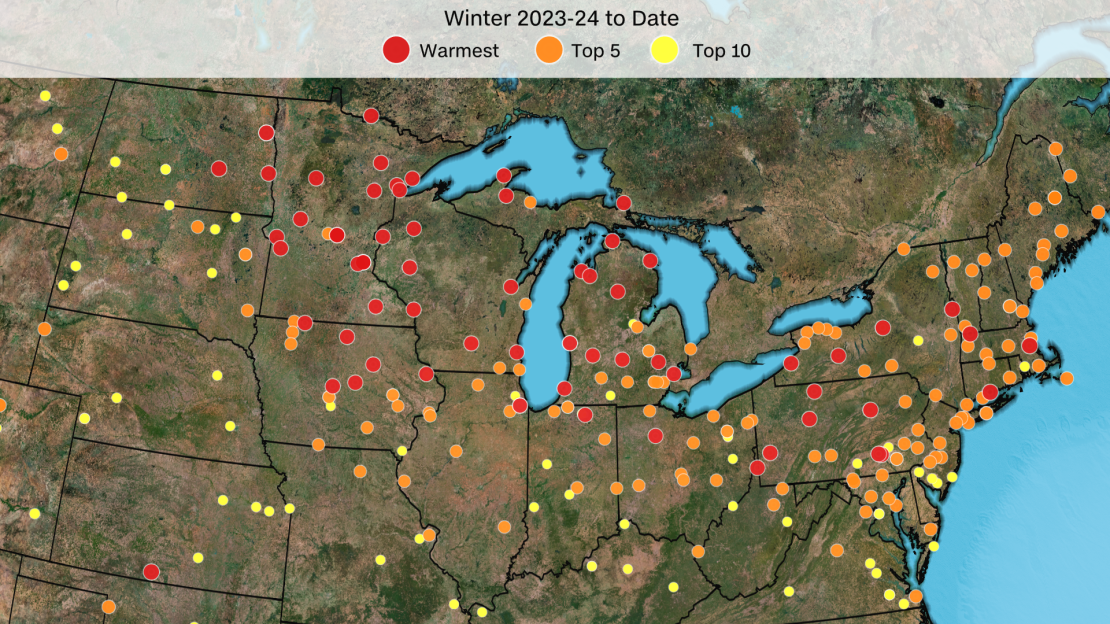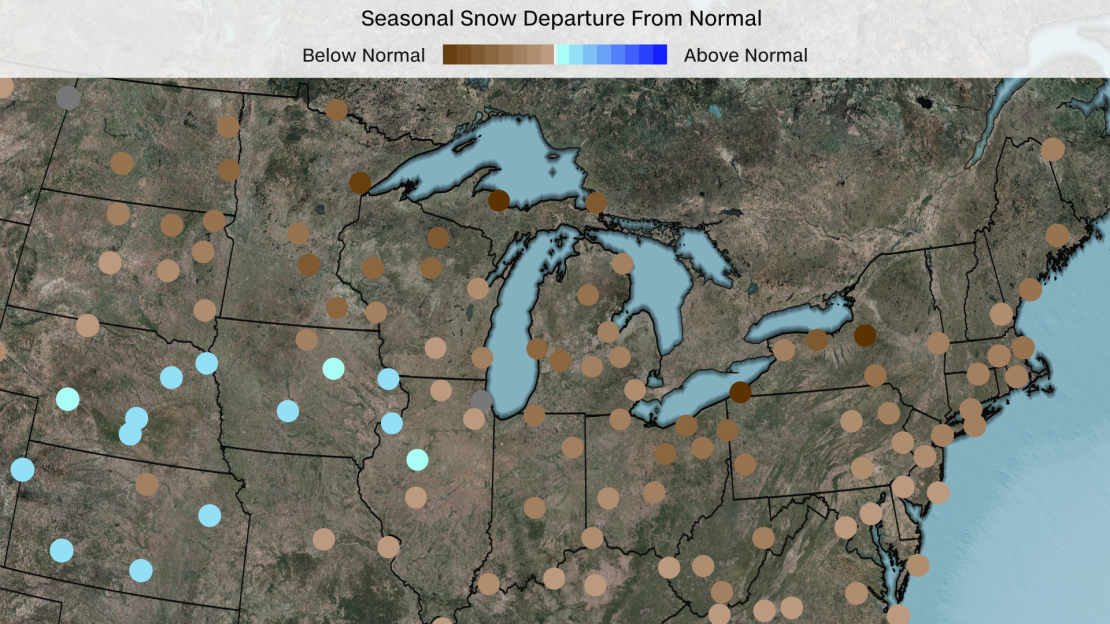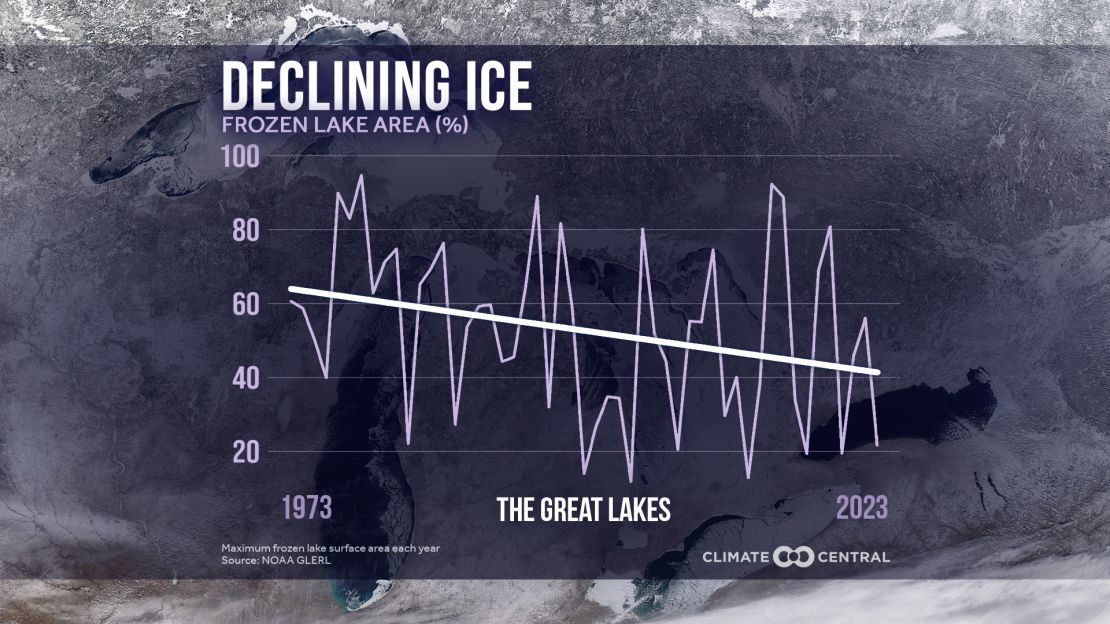Winter has gone missing across the Midwest and Great Lakes, and time is running out to find it. Dozens of cities are on track for one of the warmest winters on record, making snow and ice rare commodities.
Several cities are missing feet of snow compared to a typical winter, ice on the Great Lakes is near record-low levels and the springlike temperatures have even spawned rare wintertime severe thunderstorms.
A classic El Niño pattern coupled with the effects of a warming climate are to blame for this “non-winter” winter, said Pete Boulay, a climatologist with the Minnesota Department of Natural Resources.
Winter has become the fastest-warming season for nearly 75% of the US and snowfall is declining around the globe as temperatures rise because of human-caused climate change.
Minnesota is the epicenter of some of the season’s most unusual heat and missing snow.
“There have been past winters where we’ve had a week or two like this, maybe even a couple of weeks,” Boulay told CNN, describing the odd nature of this winter in Minnesota, before noting it hasn’t ever been this warm for this long.
“I’ve never experienced anything like it,” Boulay said. “I hooked up the hose, which is something we wouldn’t do in Minnesota during the winter, and washed my cars this past weekend.”

The state had its warmest-ever December and a toasty January despite some brief, brutal cold. The 10 days of bone-chilling cold in early January were the only ones that truly felt like winter this season, according to Boulay.
Abnormal warmth continued into February in Minnesota as temperatures the first week of the month paced between 18 and 23 degrees above average, sending people outdoors into the springlike weather.
It’s not just Minnesota: Dozens of cities from the Midwest to the Northeast are about to log one of the warmest winters on record into the history books.
Springlike warmth even opened up the door for springlike severe weather. Damaging thunderstorms rolled across Wisconsin on Thursday night and produced the state’s first February tornado.

Warmth and snow do not get along, which is evident when looking at snowfall deficits in Minnesota and the Midwest at large.
The Minneapolis-St. Paul International Airport has recorded only 4.1 inches of snow since December 1 – a deficit nearly two feet deep. Snow there has been so paltry this winter, that even Nashville – 700 miles to the southeast of the Twin Cities – has had more.
The absence of snow and cold is a huge blow to the tourism industry across Minnesota, according to Boulay. Winter recreation mainstays like snowmobiling, ice fishing, skiing and snowshoeing are all hurting.
Missing snowfall is even more pronounced in areas surrounding the Great Lakes, especially those that are typically buried by lake-effect snow. Erie, Pennsylvania, is missing around four feet this winter.
Ice has performed a disappearing act on the Great Lakes.
“We’re teetering on the edge of record low ice coverage,” Melissa Widhalm, the associate director of the Midwestern Regional Climate Center at Purdue University, told CNN.
About 36% of the Great Lakes should be covered in ice in early February, but as of Friday, total ice coverage hovered near a record low 5%, NOAA data shows.
The Great Lakes have experienced a decline in both overall coverage and longevity of ice in the past 50 years as warmer winters increase the likelihood of ice-free lakes, according to Climate Central, a nonprofit climate research group.
The lackluster ice coverage is part of a larger troubling trend across the Great Lakes. Overall maximum ice extent has dropped 25% in the last 50 years, according to Climate Central.

Robust, extensive ice is crucial for the region’s winter recreation economy. Without the ice, shorelines are left vulnerable to damaging waves and cities downwind of the lakes are at risk of prolific lake-effect snow if cold air actually arrives.
There are still a few weeks left for snow, cold and ice to make a comeback, but with more than half of winter in the rearview, an exceptional season has already made its mark.
“This winter is really going to stand out,” Boulay said.



